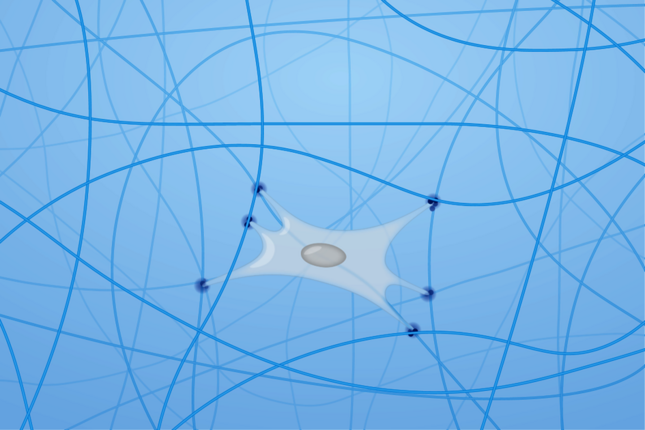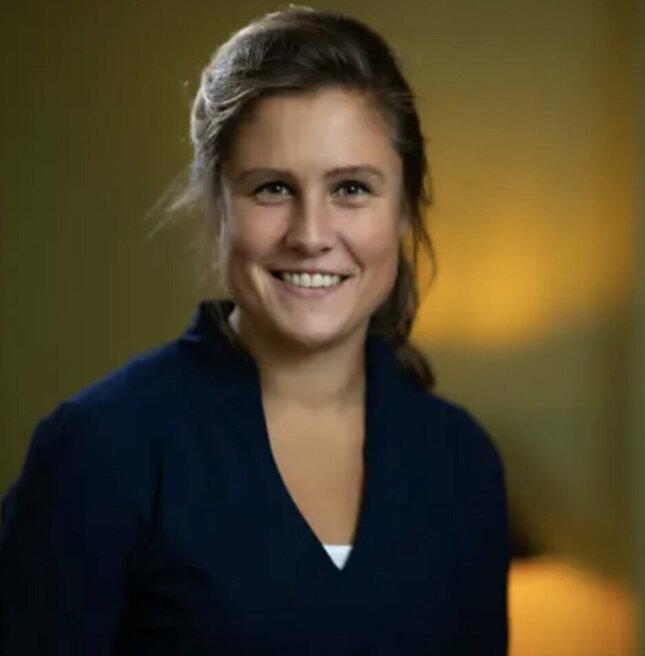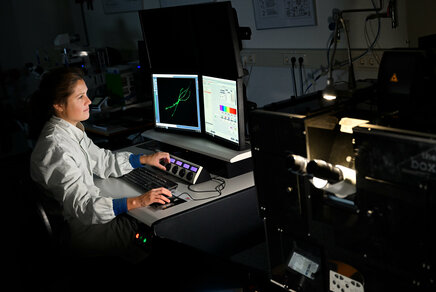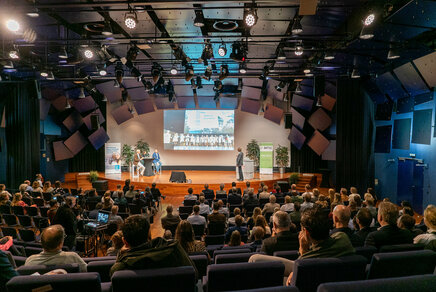The rules of growing tissue
Laura Rijns defended her PhD thesis cum laude at the Department of Biomedical Engineering on November 10th.

In human tissue, the cells are embedded in the ‘extracellular matrix’. This matrix is made up of fiber-like structures that provide firmness to the tissue, but also influence cell behavior and facilitate cell growth. PhD candidate Laura Rijns researched how you can mimic the matrix using supramolecular hydrogels. The design rules she composed to this end could contribute to the future development of more complex living tissue, for instance for testing medicine. Last Friday, she defended her dissertation at the Department of Biomedical Engineering.
“Every cell in our body is surrounded by something called the extracellular matrix,” TU/e researcher Laura Rijns tells us while showing the picture on the cover of her dissertation. As its name suggests, the extracellular matrix (ECM) is located outside of the cells, but plays an important part with respect to our biological tissue.
“This ECM consists of elongated fibers that provide firmness and structure to tissue, but also take care of the transfer of chemic signals to the cell. This happens at the attachment points,” she explains while pointing at the little blue spheres on the picture.
The ECM’s properties determine what the cell is going to do: a soft ECM will lead to soft tissue, such as brains, whereas a more rigid ECM will – for example – result in hard bone tissue. By giving information to the cell, the ECM decides ‘the cell’s fate’. So the matrix isn’t only there to bind and reinforce, but it also plays a part in the cell’s formation and functioning.

Control
With in vitro tissue models, it’s possible to improve regenerative cell therapies and test medicines. “But to make good tissue models, we have to be able to accurately mimic the ECM,” says Rijns. At the moment there is a range of natural and synthetic biomaterials we can use in this context, each with their own advantages and limitations. “The main problem with current imitations is that it’s difficult to control their properties.”
The ECM’s properties can be classified into three main categories: mechanical properties (the rigidity of the material, i.e. hard or soft), bioactive properties (the chemical signals the ECM gives to the cell) and dynamic properties (how mobile the structure is).
These properties greatly influence the behavior of cells. For example, a certain degree of mobility is required of the matrix to allow the cells to grow and form tissue. But if the fibers are too mobile, it’s difficult for a cell to latch onto an attachment point. When mimicking an ECM, it’s therefore crucial to have sufficient control of the three properties.
Supramolecular hydrogels
In her research, Rijns looked into mimicking the ECM using supramolecular hydrogels, a specific type of synthetic biomaterials offering a lot of advantages. “They’re very modular and intrinsically dynamic, which means it’s easy to incorporate functionality.”
She takes off a bead bracelet and moves the beads back and forth. “Supramolecular hydrogels consist of molecules that form weak, reversible bonds to create longer, fiber-like structures. That means they’re held together, but they’re not really attached, like these beads. So new bonds can continuously form and break down,” she explains while pulling apart some beads to illustrate her point.
This makes it easy to add molecules. “These are all green beads,” she continues, still pointing at the bracelet. “But because they aren’t attached to one another, it would be easy to insert a yellow or red bead, much the same way we can incorporate molecules with different biofunctionality at the molecular level to influence cell behavior.”

Design rules
Although the advantages of supramolecular hydrogels are clear, a lot of information is needed to use them correctly. One of the challenges is bringing together the material and the cells. “You can’t just mix the cells with the gel, as it concerns a fairly fixed structure in which you can’t simply introduce something new.
So the mixing of material and cell has to be done while it’s still a liquid,” she explains. “By playing around with the temperature, pH, concentration, and crosslinker molecules you can mix the cells and the material, both in their liquid state. By adding a crosslinker molecule at the end, the material containing the cells will turn from a liquid to a gel.”
Rijns also investigated how you can influence the mechanical, dynamic, and bioactive properties of supramolecular hydrogels to understand and control the interaction between cells and material. “For bioactivity, for instance, we looked at whether it makes a difference which type of ligand (signaling molecule, ed.) we supply. Or in terms of the bead analogy, whether it needs to be a green orb or a red cube,” she explains.
“That’s how we found out that this depends on the type of cell: for intestinal tissue you need a different ligand than for kidney tissue.”
Based on this information, she composed design rules for every matrix property influencing the interaction between cells and material. “If you’re going to grow tissue of a few cells in a lab, you can now do a much better job because you know how dynamic and rigid the matrix needs to be and what kind of bioactivity you need.”
Thanks to these guidelines, we can make sure a certain type of cell develops into a certain type of tissue or mini organ. “Before, we didn’t know how to design a matrix, whether you needed a green or blue bead and whether you wanted the consistency of mayonnaise or something firmer, like a harder jelly. Now we know.”

All out
The PhD candidate hopes the design rules can help other researchers guide the interaction between cells and material. “Even if they’re not using supramolecular hydrogels but other biomaterials, now they know approximately how rigid it needs to be.”
The design rules could eventually contribute to the development of more complex tissue for drug screening with patient-derived tissue and tissue transplants without the risk of rejection.
But these rules are also very applicable to other fields, such as bio-electronics, an emerging research field in which Rijns herself will be working after completing her PhD. In January she will start a new research project in the area of bio-electronics at Stanford University on a Niels Stensen Fellowship.
“In this field, electronic materials are developed that you can wear on or implanted into your skin, for instance. This is something where the interaction between cells and material is of the utmost importance as well, as the synthetic, electronic material must be able to accurately communicate with living cells,” she explains.
“I’m hoping to take the design rules from my PhD research and apply them to these electronic materials. This way, we aim to monitor physiological functions and, in the long term, even repair sick neuronal tissue, such as Alzheimer’s disease.”
Her dissertation is the fruit of spending thousands of hours and many long evenings at the lab; in this sense, Rijns is tireless. “If I do something, I go all out, with full commitment. Over the past four years I’ve had a hundred-percent focus on my PhD,” she admits. And she’ll be continuing her research in the US with the same passion and drive.
Her ultimate dream is to start her own lab after completing her postdoc and carry out further research into biomaterials that can accurately communicate with living tissue. One thing’s for sure: if that’s where life takes her, she’ll go all out as always.
More on Health

![[Translate to English:] [Translate to English:]](https://assets.w3.tue.nl/w/fileadmin/_processed_/e/9/csm_BvOF%20sluitstuk%20Luuk%20van%20Laake%203_c4df17db41.jpg)

Latest news


